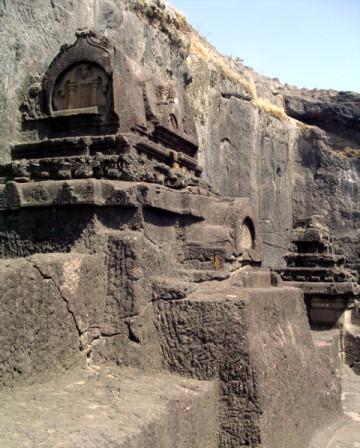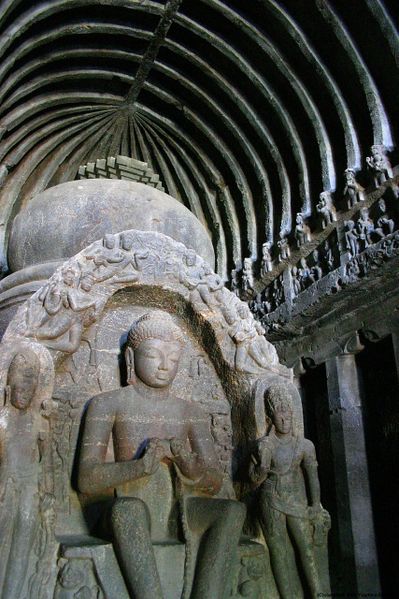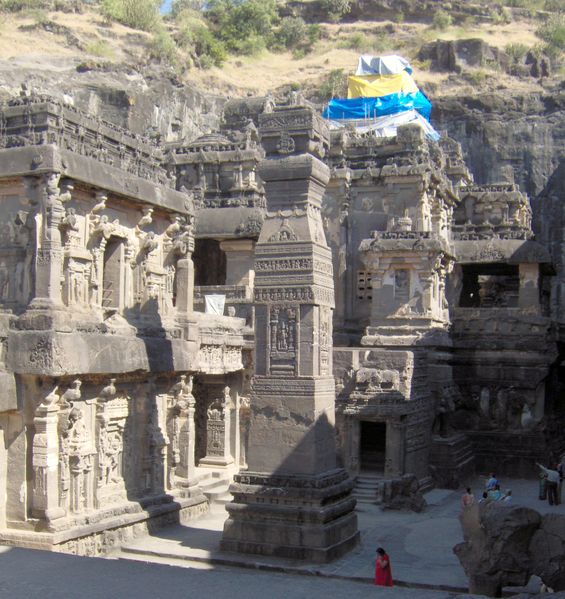Contribute
| South Asian Art - In Memory Of Prashant H. Fadia |
Art of Ajanta and Ellora
02/07/2008
While the viewer is dazzled by the vivid colors and artistry of Ajanta paintings, the architecture and the sheer mastery of the sculptors fill the viewers with awe. Ellora fills the viewer with awe . The 34 "caves" – actually structures excavated out of the vertical face of the Charanandri hills – comprised of Buddhist, Hindu and Jain cave temples and monasteries, were built between the 5th century and 10th century. The 12 Buddhist (caves 1-12), 17 Hindu (caves 13-29) and 5 Jain caves (caves 30-34), built in proximity, demonstrate the religious harmony prevalent during this period of Indian history.
The Buddhist caves were the earliest structures, created between the fifth and seventh centuries. These consist mostly of viharas or monasteries: large, multi-storied buildings carved into the mountain face, including living quarters, sleeping quarters, kitchens, and other rooms. Some of these monastery caves have shrines including carvings of Buddha, bodhisattvas and saints. In many of these caves, sculptors have endeavored to give the stone the look of wood.
Most famous of the Buddhist caves is cave 10, a chaitya hall (chandrashala) or 'Vishwakarma cave', popularly known as the "Carpenter's Cave". Beyond its multi-storeyed entry is a cathedral-like stupa hall also known as chaitya, whose ceiling has been carved to give the impression of wooden beams. At the heart of this cave is a 15 foot statue of Buddha seated in a preaching pose.
Amongst other Buddhist caves, all of the first nine (caves 1-9) are monasteries. The last two caves, Do Tal (cave 11) and Tin Tal (cave 12) have three stories.
The Hindu Caves feature several marvelous sculptures but none compares to the Kalisanath Temple. While it exhibits typical Dravidian features, it was carved out of one single rock. It was built in the 8th century by the Rashtrakuta king Krishna I.
The Kailasanath Temple is notable for its vertical excavation -- carvers started at the top of the original rock, and excavated downward, exhuming the temple out of the existing rock. The traditional methods were rigidly followed by the master architect. The architects found to design this temple were from the southern Pallava kingdom.
It is estimated that about 200,000 tons of rocks was scooped out over hundreds of years to construct this monolithic structure. From the chisel marks on walls of this temple, archeologists could conclude that three types of chisels were used to carve this temple.
All the carvings are done in more than one level. A two-storied gateway opens to reveal a U-shaped courtyard. The courtyard is edged by a columned arcade three stories high. The arcades are punctuated by huge sculpted panels, and alcoves containing enormous sculptures of a variety of deities. Originally flying bridges of stone connected these galleries to central temple structures, but these have fallen.
Within the courtyard are two structures. As is traditional in Shiva temples, an image of the sacred bull Nandi fronts the central temple housing the lingam. In Cave 16, the Nandi Mandap and main Shiva temple are each about 7 meters high, and built on two stories. The lower stories of the Nandi Mandap are both solid structures, decorated with elaborate illustrative carvings. The base of the temple has been carved to suggest that elephants are holding the structure aloft.
A living rock bridge connects the Nandi Mandap to the porch of the temple. The temple itself is tall pyramidic structure reminiscent of a South Indian temple. The shrine – complete with pillars, windows, inner and outer rooms, gathering halls, and an enormous lingam at its heart – carved from stone, is carved with niches, plasters, windows as well as images of deities, mithunas (erotic male and female figures) and other figures. Most of the deities at the left of the entrance are Shaivaite (followers of Lord Shiva) while on the right hand side the deities are Vaishnavaites (followers of Lord Vishnu).
There are two Dhvajastambhas (pillars with the flagstaff) in the courtyard. The grand sculpture of Ravana attempting to lift Mount Kailasa, the abode of Lord Shiva, with his full might is a landmark in Indian art.
These caves are one of the finest examples of religious tolerance. If the goal of the artists in the Ajanta Ellora caves was to create the highest spiritual experience for their viewers they have succeeded beyond their wildest imagination.
You may also access this article through our web-site http://www.lokvani.com/


